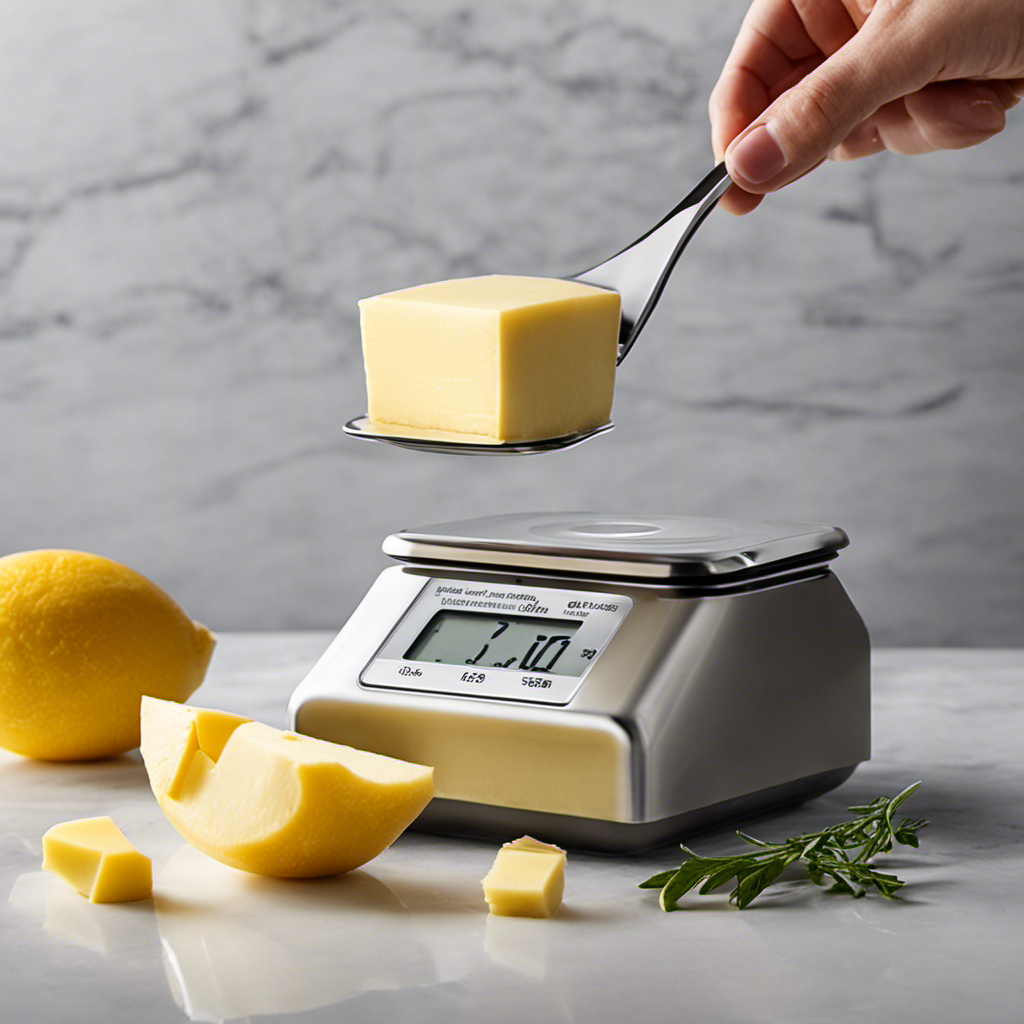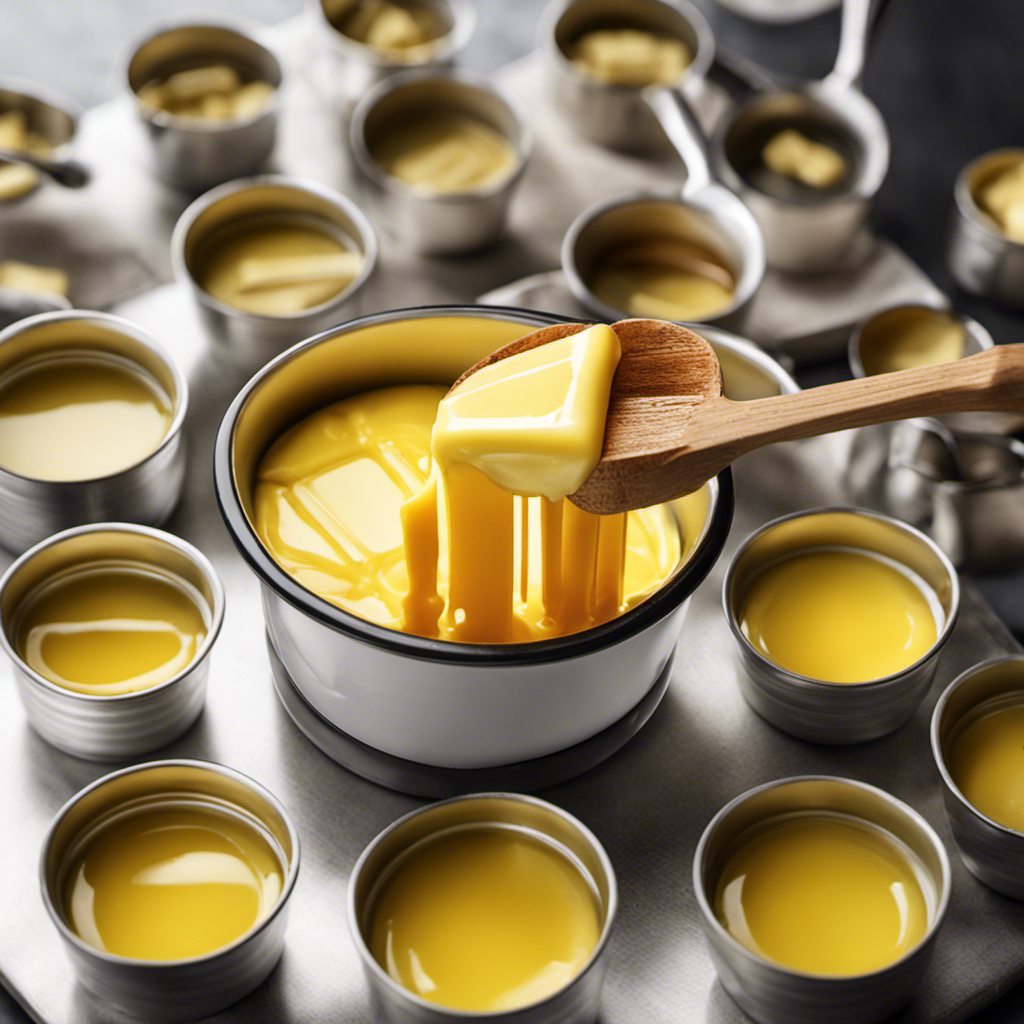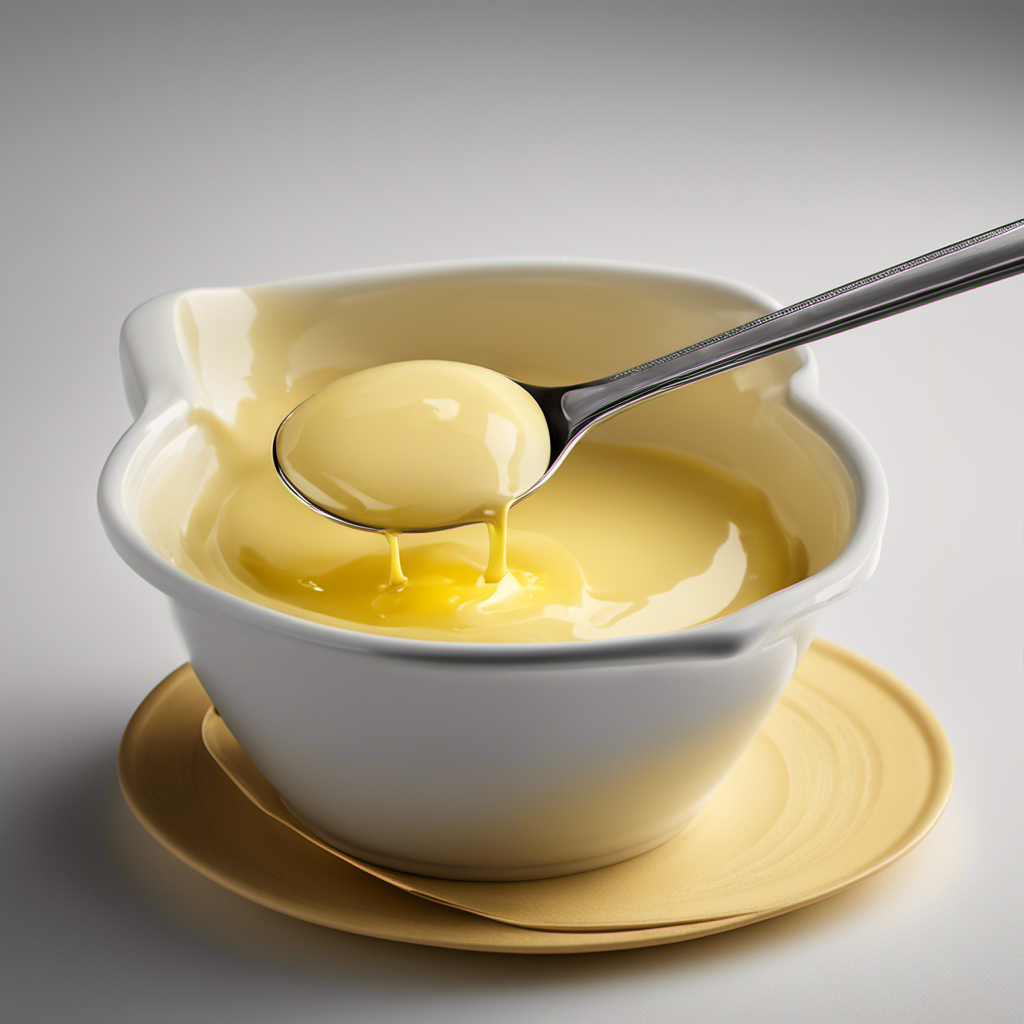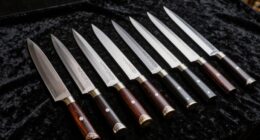As someone who passionately loves butter, I frequently find myself in the kitchen, pondering the weight of a cup of butter. With the curiosity of a scientist, I embarked on a quest to solve this puzzle and deliver the information you’re looking for.
In this article, we’ll delve into the world of butter measurements, exploring conversions, weights, and the importance of accuracy.
So, grab your apron and let’s embark on this buttery journey together.
Key Takeaways
- A cup of butter typically weighs about 227 grams.
- Converting between cups and grams is important for accurate measurement.
- Using a kitchen scale ensures precise measurements for better recipe outcomes.
- Measuring butter by weight ensures consistency and enhances flavor and texture in dishes.
Understanding Butter Measurements
A cup of butter typically weighs about 227 grams. Understanding butter measurement conversions is essential when it comes to measuring butter for cooking.
Whether you’re following a recipe or experimenting in the kitchen, knowing how much butter to use is crucial for achieving the desired results. Some recipes may call for butter to be measured in cups, while others might specify weight in grams.
Converting between these units can be confusing, but it’s not as complicated as it seems. By knowing that a cup of butter weighs approximately 227 grams, you can easily convert between the two measurements.
Now that we have a grasp on converting cups to ounces of butter, let’s explore the next section about converting cups to ounces.
Converting Cups to Ounces: Butter
Converting cups of butter to ounces can be easily done using a kitchen scale. It’s important to know the weight of butter, as it can greatly impact the outcome of your recipes.
Sometimes, a recipe might call for a specific weight of butter, rather than a measurement in cups. This is because butter weight alternatives, such as ounces, provide a more accurate way to measure the ingredient.
Using a kitchen scale allows you to achieve precise measurements, ensuring that your recipes turn out perfectly every time. The weight of butter can affect the texture, moisture, and overall taste of your dishes, so it’s worth taking the time to convert your measurements.
With a kitchen scale, you can confidently measure butter in ounces, knowing that your recipes will be a success.
The Weight of a Cup of Butter
To accurately measure the weight of butter in a cup, you can use a kitchen scale. Understanding butter density is key to converting cups to grams.
Butter is denser than water, so a cup of butter will weigh more than a cup of water. The density of butter can vary depending on its temperature and fat content.
Generally, a cup of solid butter weighs around 227 grams, while a cup of melted butter weighs around 227 grams as well. However, it’s important to note that these measurements are approximate, as the density of butter can differ between brands and types.
To get the most accurate measurement, it’s recommended to weigh your butter on a kitchen scale rather than relying solely on volume measurements.
How to Measure Butter by Weight
If you want an accurate measurement of butter, all you need to do is use a kitchen scale. It’s the best way to ensure you’re using the right amount in your recipes.
Here’s why measuring butter by weight is important:
-
Consistency: Butter can vary in density, so measuring by volume can lead to inconsistent results.
-
Precision: When baking, precision is key. Using a scale allows you to be exact in your measurements.
-
Converting recipes: Many recipes provide butter measurements in weight, so converting from volume is necessary.
-
Easy calculations: Converting butter measurements for cooking is a breeze with a scale. No need for complex calculations or guessing.
By using a kitchen scale, you’ll be able to accurately measure your butter, ensuring the perfect balance of flavor and texture in your dishes.
But if you’re unsure about the weight conversions, don’t worry! A butter weight conversion chart can help you make the switch seamlessly.
Butter Weight Conversion Chart
Using a butter weight conversion chart, you can easily determine the correct measurements for your recipes. When it comes to cooking with butter, it’s important to know the weight conversions for different measurements. This can be especially helpful when dealing with recipes that call for specific amounts of butter. To make things easier for you, I’ve created a handy butter weight conversion chart:
| Measurement | Weight |
|---|---|
| 1 tablespoon | 14 grams |
| 1/4 cup | 57 grams |
| 1/2 cup | 113 grams |
| 1 cup | 227 grams |
Why Knowing Butter Weight Matters
Knowing the weight conversions for butter is essential for accurately measuring ingredients in your recipes. As a home cook, I have learned the importance of converting butter measurements to ensure that my baked goods turn out perfectly every time.
Here are four techniques I use to convert butter measurements:
-
Use a kitchen scale: Weighing butter ensures accuracy and consistency in your recipes.
-
Use a conversion chart: These handy charts provide measurements for butter in cups, tablespoons, and grams.
-
Follow the markings on the packaging: Many butter packages have markings indicating tablespoon and cup measurements.
-
Use the displacement method: Fill a measuring cup with water, then add butter until the water level rises to the desired measurement.
Butter Measurement Tips and Tricks
When it comes to baking, accurate measurements are crucial, especially when it comes to butter. In this discussion, I will be covering three key points.
First, butter conversion charts are incredibly helpful when you need to convert between different measurements, such as sticks, cups, or grams. These charts provide a quick and easy reference for accurately measuring butter in different units.
Second, I will share some tips on how to measure butter accurately, whether you’re using a scale or measuring by volume. Accurate measurements ensure that you are using the right amount of butter in your recipe, which can greatly affect the texture and taste of your baked goods.
Finally, I will explore some alternatives to butter for those who either can’t have dairy or prefer to use healthier options in their recipes. There are a variety of substitutes available, such as coconut oil, avocado, or applesauce, that can be used to replace butter in your baking.
Overall, understanding butter conversion charts, knowing how to measure butter accurately, and being aware of alternative options can greatly enhance your baking experience and allow you to create delicious treats that meet your specific needs and preferences.
Butter Conversion Charts
Butter conversion charts can be helpful for determining the weight of a cup of butter. Here are four reasons why they are a useful tool when cooking with butter:
-
Accuracy: Conversion charts provide precise measurements, ensuring your recipe turns out perfectly every time.
-
Convenience: Instead of guessing or estimating the weight of butter, charts make it easy to convert between cups, grams, ounces, and tablespoons.
-
Consistency: Using accurate measurements helps maintain consistency in your recipes, resulting in consistent flavors and textures.
-
Adaptability: Conversion charts allow you to adjust recipes based on the amount of butter you have on hand, making it easy to scale up or down as needed.
Accurate Butter Measuring
Using a conversion chart ensures you have precise measurements for accurately measuring butter in your recipes. When it comes to converting butter measurements for cooking, it can be confusing to know exactly how much butter to use. That’s why having a conversion chart handy is essential. With a conversion chart, you can easily determine the equivalent measurements for butter in different forms, such as tablespoons, cups, or grams. To give you a better idea, here’s a handy table:
| Butter Measurement | Equivalent |
|---|---|
| 1 stick | 1/2 cup |
| 1/2 stick | 1/4 cup |
| 1 tablespoon | 14 grams |
| 1 cup | 227 grams |
Substitutes for Butter
To find suitable alternatives, you can explore other options that provide similar texture and flavor in your recipes. When it comes to butter substitute options, there are a variety of choices that not only offer great taste but also provide health benefits.
Here are four alternatives to consider:
-
Avocado: This creamy fruit is a perfect substitute for butter in baking and cooking. It adds a rich and moist texture to your dishes while providing essential nutrients like healthy fats and fiber.
-
Coconut oil: Known for its tropical flavor, coconut oil works well as a substitute in both sweet and savory recipes. It offers a unique taste and is packed with medium-chain triglycerides that can boost metabolism.
-
Greek yogurt: If you’re looking to reduce fat in your recipes, Greek yogurt is a fantastic option. It adds creaminess and moisture while providing protein and probiotics for a healthy gut.
-
Applesauce: For a low-fat and low-calorie alternative, applesauce can be used in baking to replace butter. It adds natural sweetness and moisture to your treats without sacrificing flavor.
The Importance of Accurate Butter Measurements
Accurate measurements are crucial when baking with butter. As a passionate baker, I have learned the hard way that even a slight miscalculation can have a significant impact on the outcome of a recipe.
That’s why understanding butter measurement hacks is essential. One common mistake is using cold butter when a recipe calls for softened butter. This can lead to dense and heavy baked goods. On the other hand, if you use too much butter, your cookies may spread excessively, resulting in thin and greasy treats.
Inaccurate butter measurements can throw off the balance of flavors and textures in your baked goods, leaving you with less-than-perfect results. To avoid this, always measure butter accurately, using a kitchen scale or the markings on the butter wrapper.
Your baked treats will thank you!
Converting Butter Measurements for Baking
When it comes to baking, accurate measurements are crucial. As I mentioned earlier, butter is a common ingredient in many recipes. But how do we convert butter measurements effectively? Here are a few techniques and methods to help you navigate the world of butter weight conversions:
-
Using a kitchen scale: This is the most accurate method. Simply weigh the required amount of butter in grams or ounces.
-
Butter sticks: In the United States, butter is often sold in sticks, each weighing 4 ounces or 113 grams. This makes it easy to measure if your recipe calls for a specific number of sticks.
-
Butter volume conversions: If you don’t have a scale, you can use volume conversions. One cup of butter is equal to 227 grams or 8 ounces.
-
Online conversion tools: There are numerous websites and apps available that can quickly convert butter measurements for you.
With these butter measurement techniques and butter weight conversion methods, you’ll be able to accurately follow any recipe and achieve delicious results in your baking endeavors.
Exploring Different Butter Weight Standards
When it comes to butter, there’s more than meets the eye – or should I say, the scale. In this discussion, we’ll delve into the fascinating world of different butter weight standards.
We’ll explore the international variations, regional differences, and even take a step back in time to uncover the historical norms.
Get ready to have your mind churned with buttery knowledge!
International Butter Weight
Butter weight varies internationally, so a cup of butter may weigh differently in different countries. This can be a challenge when following recipes from different regions. Here are some interesting facts about international butter weight and its impact on cooking techniques:
-
Regional butter preferences: Different countries have their own preferred types of butter, which can vary in fat content and moisture. This affects the weight of a cup of butter, as the fat content can significantly impact the overall weight.
-
Conversion challenges: When converting recipes from one country to another, it’s important to consider the differences in butter weight. A cup of butter in one country may be lighter or heavier than a cup of butter in another country, leading to potential inaccuracies in the final dish.
-
Baking precision: Baking is a science that requires precise measurements. When recipes call for specific amounts of butter, it’s important to be aware of the regional differences in butter weight to ensure accurate and consistent results.
-
Adjusting for taste and texture: Butter weight can also affect the taste and texture of dishes. For example, a lighter cup of butter may result in a fluffier cake, while a heavier cup of butter may yield a denser, richer flavor.
Understanding the variations in international butter weight is crucial for achieving the desired results in cooking and baking. It’s important to be mindful of these differences and make adjustments as necessary to ensure delicious and successful dishes.
Regional Variations in Weight
Regional variations in weight can impact the accuracy of recipes and the final outcome of dishes. It’s fascinating to explore cultural variations in cooking and how they can affect the measurements we use in recipes.
For example, in some regions, a cup of butter may weigh slightly more or less than in others. This can have a significant impact on the texture and taste of the final dish. Imagine making a delicate cake and unknowingly using a cup of butter that is heavier than what the recipe calls for. The result could be a dense and greasy cake instead of a light and fluffy one.
It’s important to be aware of these regional variations and adjust our measurements accordingly to ensure the best possible outcome in our cooking adventures.
Historical Butter Weight?
It’s interesting to consider the historical variations in weight for this essential cooking ingredient. Butter has been a staple in kitchens around the world for centuries, and its weight has varied depending on the time and place. Here are some intriguing historical butter measurements and regional butter weight variations:
-
Ancient Greece: In ancient Greece, butter was measured using the weight of a drachma, which was approximately 4.3 grams.
-
Medieval Europe: During the Middle Ages, butter was commonly measured in pounds, with the weight varying from region to region. In England, a pound of butter weighed around 454 grams, while in France, it was closer to 500 grams.
-
Colonial America: In colonial America, butter was often measured in pounds and ounces. A pound of butter weighed approximately 454 grams, while an ounce of butter was around 28 grams.
-
Modern standard: Nowadays, a cup of butter typically weighs 227 grams or 8 ounces.
Understanding the historical butter measurements and regional variations adds a fascinating layer to our appreciation of this versatile ingredient.
Common Mistakes in Measuring Butter Weight
One of the most common mistakes when measuring butter weight is not properly softening it before measuring. Softening butter allows for more accurate measurement as it ensures that the butter is evenly distributed and easily scooped or poured. Another mistake people often make is using the wrong measuring tool. Measuring butter in cups can be tricky as it can vary depending on how it is packed. To avoid this, it is best to use a kitchen scale for precise measurement. Lastly, not taking into account the temperature can also lead to inaccurate measurements. Butter can change in weight depending on whether it is cold or at room temperature. To help you understand the importance of accurate butter measurement, here is a table showcasing the weight of different butter measurements:
| Butter Measurement | Weight in grams | Weight in ounces |
|---|---|---|
| 1 tablespoon | 14g | 0.5 oz |
| 1/4 cup | 57g | 2 oz |
| 1 cup | 227g | 8 oz |
Frequently Asked Questions
Can I Use Margarine Instead of Butter in Baking Recipes?
Sure, you can use margarine instead of butter in baking recipes. Margarine can provide a similar texture and flavor to butter. However, it’s important to note that margarine may not be a healthier alternative to butter due to its higher levels of trans fats.
How Do I Convert Grams of Butter to Tablespoons?
Converting butter measurements can be tricky, especially without a scale. But fear not! I’ll show you how to measure butter accurately using tablespoons. Stay tuned for a simple and foolproof method!
Does the Type of Butter Affect Its Weight?
The type of butter can affect its weight due to variations in fat content. Higher fat content can result in a denser butter, making it weigh more. Additionally, temperature can also impact the weight of butter as it can melt or solidify.
Are There Any Tips for Measuring Butter Without a Scale?
Measuring butter without a scale can be tricky, but there are tips to make it easier. Converting butter measurements without a scale involves using measuring spoons or estimating based on the packaging.
Can I Substitute Oil for Butter in a Recipe and if So, How Does It Affect the Overall Weight?
Yes, you can substitute oil for butter in a recipe. When doing so, keep in mind that oil is lighter than butter, so the overall weight of the dish may be slightly different.
Conclusion
In conclusion, understanding the weight of a cup of butter is essential for accurate baking and cooking. By converting cups to ounces and using a butter weight conversion chart, you can ensure precise measurements every time.
Remember to measure butter by weight rather than volume for consistent results. Avoid common mistakes in measuring butter weight and explore different butter weight standards to find what works best for you.
With accurate butter measurements, you’ll be ready to create delicious and perfectly balanced recipes.









